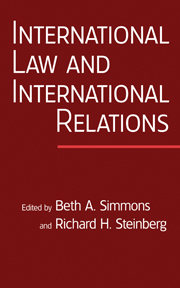Book contents
- Frontmatter
- Contents
- Contributors
- Abstracts
- Preface
- Editors' Note
- PART I INTERNATIONAL REGIMES THEORY: DOES LAW MATTER?
- PART II COMMITMENT AND COMPLIANCE
- PART III LEGALIZATION AND ITS LIMITS
- PART IV INTERNATIONAL LAW AND INTERNATIONAL NORMS
- PART V TREATY DESIGN AND DYNAMICS
- 13 Why Are Some International Agreements Informal? (1991)
- 14 The Politics of Dispute Settlement Design: Explaining Legalism in Regional Trade Pacts (2000)
- 15 Loosening the Ties that Bind: A Learning Model of Agreement Flexibility (2001)
- 16 Driving with the Rearview Mirror: On the Rational Science of Institutional Design (2001)
- 17 The Dynamics of International Law: The Interaction of Normative and Operating Systems (2003)
- PART VI LAW AND LEGAL INSTITUTIONS
- PART VII OTHER SUBSTANTIVE AREAS OF INTERNATIONAL LAW
- References
- Index
15 - Loosening the Ties that Bind: A Learning Model of Agreement Flexibility (2001)
Published online by Cambridge University Press: 05 June 2012
- Frontmatter
- Contents
- Contributors
- Abstracts
- Preface
- Editors' Note
- PART I INTERNATIONAL REGIMES THEORY: DOES LAW MATTER?
- PART II COMMITMENT AND COMPLIANCE
- PART III LEGALIZATION AND ITS LIMITS
- PART IV INTERNATIONAL LAW AND INTERNATIONAL NORMS
- PART V TREATY DESIGN AND DYNAMICS
- 13 Why Are Some International Agreements Informal? (1991)
- 14 The Politics of Dispute Settlement Design: Explaining Legalism in Regional Trade Pacts (2000)
- 15 Loosening the Ties that Bind: A Learning Model of Agreement Flexibility (2001)
- 16 Driving with the Rearview Mirror: On the Rational Science of Institutional Design (2001)
- 17 The Dynamics of International Law: The Interaction of Normative and Operating Systems (2003)
- PART VI LAW AND LEGAL INSTITUTIONS
- PART VII OTHER SUBSTANTIVE AREAS OF INTERNATIONAL LAW
- References
- Index
Summary
Existing international agreements are testament to state's willingness and ability to cooperate despite the international anarchy in which they find themselves. Given the difficulties of cooperation under anarchy documented in the recent international relations literature, understanding how states manage to bring about the formal cooperation embodied in international agreements is of both theoretical and practical interest.
States can make agreements more desirable in prospect and more robust in practice by varying their provisions for duration and renegotiation. These provisions help states account for the uncertain economic, political, and technological contexts in which agreements are made and (ideally) kept.
Nevertheless, the issues of duration and renegotiation have been almost completely ignored in the political science literature on international relations. They have been wholly neglected in theoretical studies of international cooperation, and there has been surprisingly little discussion of these issues from an empirical point of view. In fact, although some discussions of individual agreements cover the issues of duration and renegotiation for the agreement in question, no work exists that attempts to account for or even describe the observed patterns and variation in agreement duration and renegotiation.
What I am attempting essentially is to bring theory – in particular, formal international relations theory – to international law.
- Type
- Chapter
- Information
- International Law and International RelationsAn International Organization Reader, pp. 375 - 402Publisher: Cambridge University PressPrint publication year: 2007

